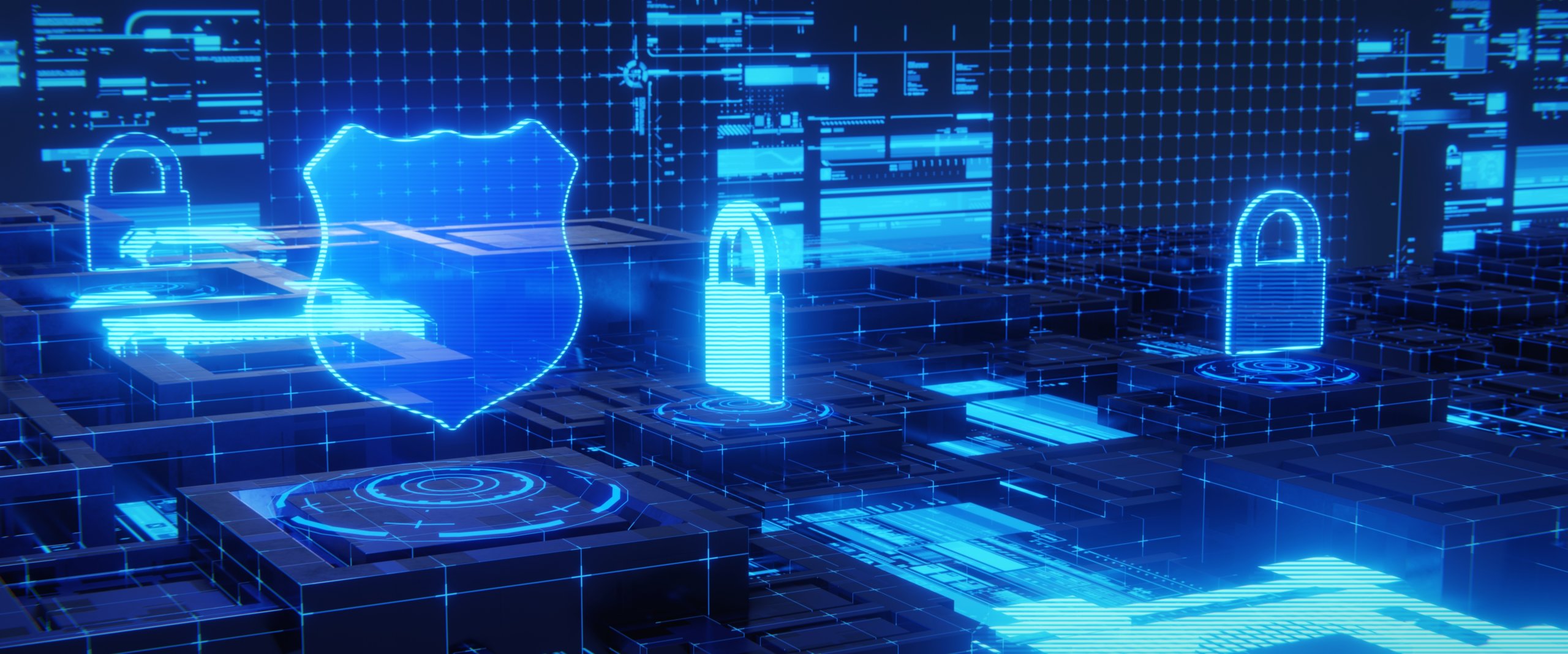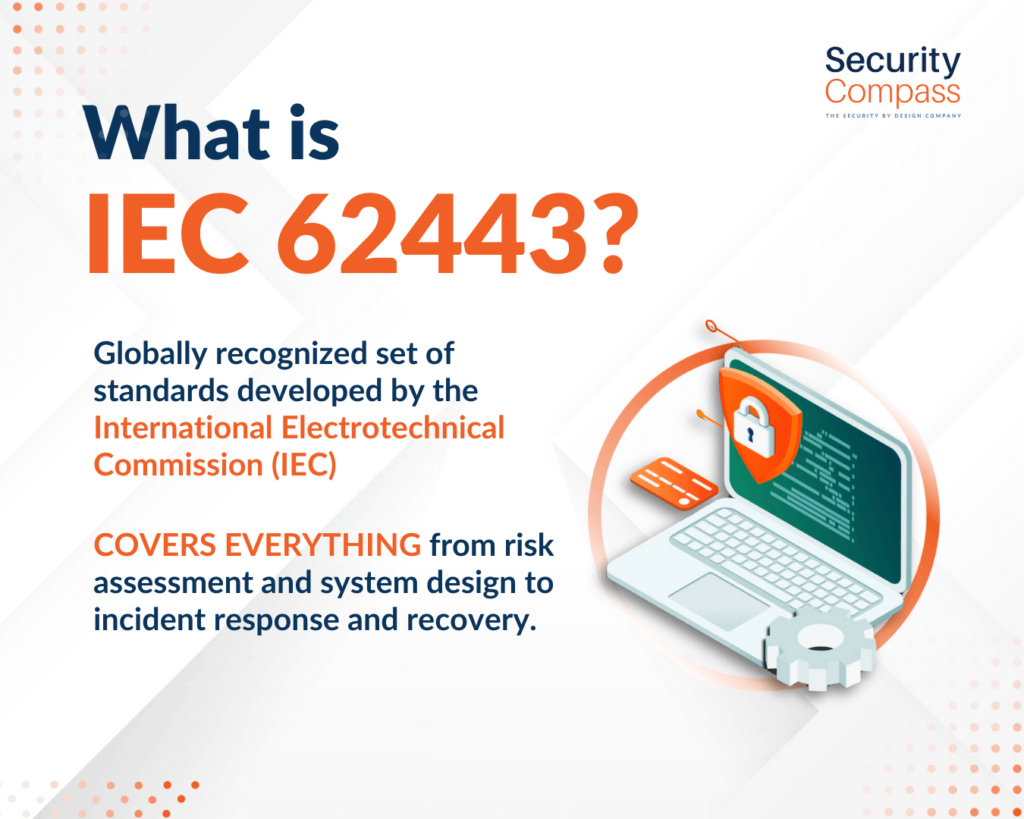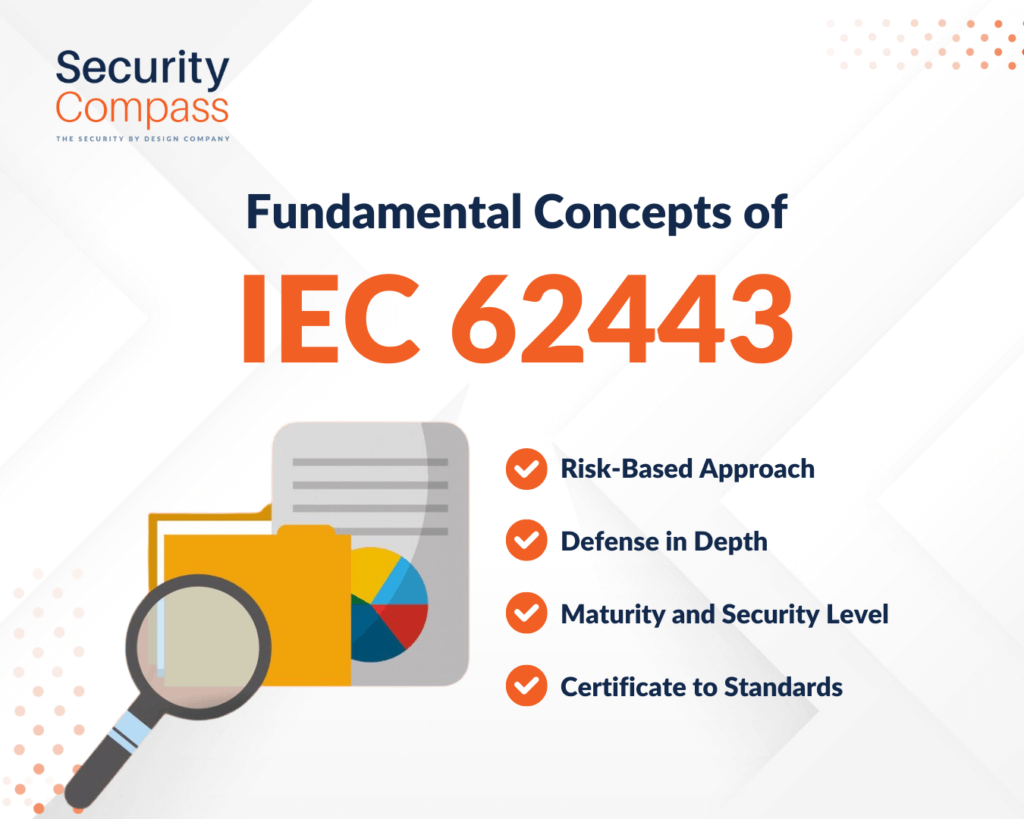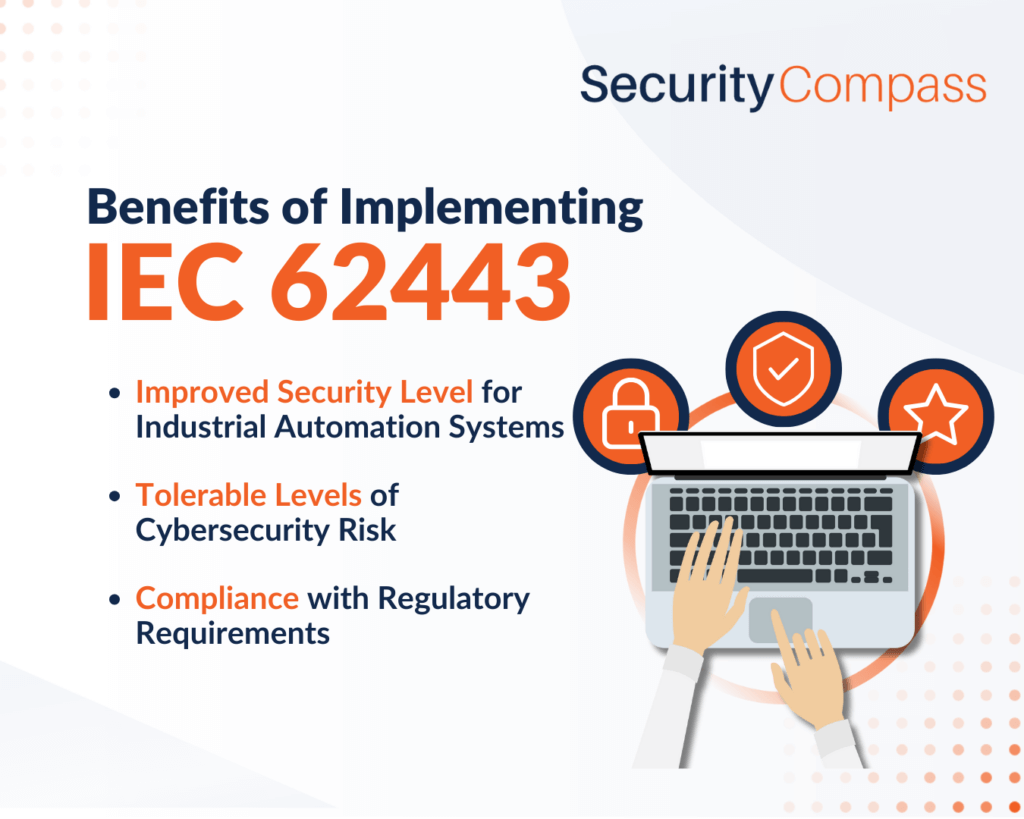If you’re involved in industrial automation systems or their security, you have probably encountered the International Electrotechnical Commission’s IEC 62443 standard. The IEC 62443 is a series of standards developed to secure Industrial Automation and Control Systems (IACS) from cyber threats. In the following post, we’ll explain what IEC 62443 is, why it’s essential, and how it’s implemented to provide robust security solutions for industrial systems. Stay with us as we journey into the heart of industrial cybersecurity.
What is IEC 62443?
IEC 62443 is a globally recognized set of standards developed by the International Electrotechnical Commission (IEC) that provides a framework for securing industrial automation and control systems.
The IEC 62443 standards encompass all layers of an organization’s industrial control system (ICS), from the operator level to the enterprise level and everything in between. This includes components such as programmable logic controllers (PLCs), network devices, and SCADA software, as well as the human-machine interfaces (HMIs) that operators use to interact with these systems.
The standards are not specific to any industry and can be applied in any sector where ICS is used, including manufacturing, energy, water treatment, and transportation. They are intended to be flexible enough to adapt to varying levels of risk and different types of threats, making them suitable for a wide range of industrial environments.
In essence, IEC 62443 provides a comprehensive approach to cybersecurity, addressing not only technical aspects but also organizational and procedural matters. It covers everything from risk assessment and system design to incident response and recovery, providing a roadmap for organizations to establish a robust and resilient cybersecurity posture in their industrial operations.
History of IEC 62443
The history of IEC 62443 dates back to 2022, with the formation of a dedicated committee by the International Society of Automation (ISA). This committee, known as ISA99, was tasked with establishing standards and guidelines to ensure the security of industrial automation and control systems.
The ISA99 committee brought together diverse cybersecurity experts from various sectors, including manufacturing, utilities, and technology vendors. It recognized the growing threat of cyber-attacks on industrial systems and the need for a comprehensive standard that could be applied across different industries and organizations.
The initial work of the ISA99 committee culminated in creating a series of standards named ISA-99, which laid out the foundation for securing industrial automation and control systems. These standards addressed various aspects of cybersecurity, including defining key concepts and models, establishing a cybersecurity management system, and providing guidelines for system design, implementation, operation, and maintenance.
Recognizing the universal applicability and importance of these standards, the International Electrotechnical Commission (IEC) adopted them as IEC 62443 in 2010. The IEC is a leading global organization that publishes international standards for all electrical, electronic, and related technologies.
Since then, IEC 62443 has been continually updated and expanded to keep up with the evolving cyber threat landscape and technological advancements in industrial automation. Today, it stands as one of the most comprehensive and widely recognized standards for industrial cybersecurity worldwide.
The development and evolution of IEC 62443 represents a significant collaborative effort by numerous stakeholders worldwide. It reflects the global commitment to ensuring the security of our industrial systems and infrastructure against increasingly sophisticated cyber threats.
The ISA99 Committee
The ISA99 Committee is a vital part of the history and ongoing development of the IEC 62443 standards. Formed by the International Society of Automation (ISA), the committee was established with the specific goal of creating a robust set of standards to help secure industrial automation and control systems from cyber threats.
The ISA99 Committee consists of a diverse group of experts drawn from different sectors across the globe. The members include representatives from manufacturing companies, utilities, system integrators, security solution providers, and technology vendors. The team also comprises consultants, academics, and government officials, all bringing unique perspectives and expertise to the table.
The committee’s primary task was to develop detailed guidelines and best practices for implementing secure industrial automation and control systems. However, their work didn’t stop at merely crafting the standards. They also promoted these standards within the industry and provided education and resources to help organizations understand and implement them effectively. The ISA99 concerns itself with automation and control systems whose compromise could result in any or all of the following situations:
- Endangerment of public or employee safety
- Environmental protection
- Loss of public confidence
- Violation of regulatory requirements
- Loss of proprietary or confidential information
- Economic loss
- Impact on entity, local, state, or national security
Since its inception, the ISA99 Committee has made significant contributions to the field of industrial cybersecurity. The standards they developed under the ISA-99 series served as the basis for the IEC 62443 standards, which are now recognized globally. Despite this achievement, the committee continues to work towards refining and expanding these standards to address the evolving cyber threat landscape and technological advancements in industrial automation. For more information on the ISA99 committee, check out the ISA99 section on the ISA page.
Reasons for Developing IEC 62443
The development of the IEC 62443 series of standards was driven by several key factors, all of which underscored the critical need for robust cybersecurity measures in industrial automation and control systems (IACS). Here are some of the primary reasons:
- Expanding Use of IACS Across Various Sectors: Originally designed for the industrial process sector, IACS has found wide-ranging applications in diverse industries, including power and energy supply and distribution, transport, and others. Given that these technologies form the backbone of critical infrastructure, securing them became an urgent necessity.
- Inadequacy of IT Standards for IACS: Traditional IT standards were found to be ill-suited for IACS and other operational technology (OT) environments, primarily due to differences in performance, availability requirements, and equipment lifetimes. More importantly, while cyber-attacks on IT systems mainly have economic implications, attacks on critical infrastructure can lead to severe environmental damage, public health crises, and loss of life.
- Rising Cyber Threat Landscape: With the increasing sophistication of cyber threats, it became clear that industry-specific standards based on best practices were needed to mitigate the effects of successful cyber-attacks, bolster security throughout the lifecycle of IACS, and reduce associated costs.
- Need for a Holistic Approach: Recognizing that not all risks are technology-based, the developers of IEC 62443 aimed to create a standard that addresses the entire ecosystem surrounding IACS. This includes not only the technology itself but also the work processes, countermeasures, and most importantly, the people involved. The staff responsible for an IACS must have the necessary training, knowledge, and skills to ensure security.
- Risk-Based Approach: IEC 62443 adopts a risk-based approach to cybersecurity, acknowledging that it is neither efficient nor sustainable to protect all assets equally. Instead, organizations are encouraged to identify their most valuable assets, assess their vulnerabilities, and then erect a defense-in-depth architecture that ensures business continuity.
In summary, the primary motivation behind the development of IEC 62443 was to create a comprehensive, adaptable, and effective framework for securing IACS against the growing threat of cyber-attacks. Given the crucial role these systems play in numerous industries and critical infrastructure, the importance of such a standard cannot be overstated.
Fundamental Concepts of IEC 62443
IEC 62443, a series of standards developed to secure industrial automation and control systems (IACS), outlines several security requirements. These requirements are designed for various stakeholder groups, including operators, service providers, and component/system manufacturers. Here are the key security requirements as per the IEC 62443 standards:
- Risk-Based Approach: IEC 62443 promotes a risk-based approach to cybersecurity. This means identifying the most valuable assets, assessing their vulnerabilities, and then implementing protective measures accordingly. The standard discourages trying to protect all assets equally, highlighting it as neither efficient nor sustainable. Part 3-2 of the guidelines addresses cybersecurity risks in Industrial Automation and Control Systems (IACS), emphasizing the use of zones and conduits and maintaining a flexible approach towards risk assessment methodologies, which should align with an organization’s overall strategy. Zones are defined as groupings of assets based on various criteria like risk or function, while conduits are logical groupings of communication channels connecting these zones. Effective partitioning into zones and conduits is crucial for reducing cybersecurity risks and limiting the impact of cyber-attacks. Additionally, Part 3-2 mandates documenting security countermeasures and requirements in a Cybersecurity Requirements Specification (CRS), which integrates into IACS documentation and includes detailed system descriptions and countermeasures. Furthermore, Part 4-1 introduces requirements for the security development lifecycle of control systems, with a strong focus on threat modeling to identify and mitigate security vulnerabilities throughout the product’s lifecycle.
- Defense in Depth: The standard recommends a multi-layered defense strategy, known as ‘defense in depth’. This strategy involves implementing multiple levels of security controls throughout the system to provide redundancy, ensuring that if one measure fails or a vulnerability is exploited, other protective layers remain intact.
- Maturity and Security Levels: IEC 62443 describes four levels of maturity for processes (based on the Capability Maturity Model Integration (CMMI) framework) and five Security Levels (SL) for evaluating technical requirements (IEC 62443-3-3 and IEC 62443-4-2). While Security Levels measure the effectiveness of the Technical Requirements, Maturity Levels measure the people, policies, and procedures. Security levels indicate resistance against different classes of attackers and should be evaluated per technical requirement, while maturity levels indicate that all process-related requirements that apply to a particular maturity level have been practiced during product development and integration.
- Certification to Standards: IEC 62443 encourages certification of processes, systems, and products used in industrial automation environments as per the standard. Several global testing, inspection, and certification (TIC) companies offer product and process certifications based on IEC 62443.
In summary, the IEC 62443 standards provide a comprehensive set of security requirements for IACS, focusing on a risk-based approach, defense-in-depth strategy, secure product development, and certification. These requirements are designed to ensure robust cybersecurity measures are in place throughout the lifecycle of IACS, thereby protecting critical infrastructure from potential cyber threats.
IEC 62443 Document Structure
The IEC 62443 series of standards is organized into four main parts, each focusing on different aspects of industrial automation and control systems (IACS) security:
- General: This part addresses topics common to the entire series, laying the foundational concepts and models. It sets the stage for the more specific guidelines and requirements presented in subsequent parts.
- Policies and Procedures: This segment delves into the methods and processes associated with IACS security. It includes documents like 62443-2-1, which outlines the requirements for defining and implementing an effective IACS cybersecurity management system, and 62443-2-4, which details requirements for IACS service providers across various topics such as assurance, architecture, wireless, security engineering systems, and more.
- System: This part focuses on system-level requirements. It includes standards like 62443-3-2, which deals with security risk assessment and system design, and 62443-3-3, which specifies system security requirements and security levels. This part is crucial for understanding the broader system implications of security in IACS environments.
- Components and Requirements: The final part provides detailed requirements for IACS products. This includes standards like 62443-4-1, which defines secure product development processes, and 62443-4-2, which sets out technical security requirements for IACS components. This part also includes common component security constraints (CCSC) that components must meet to be compliant with these standards.
Foundational Requirements of IEC 62443
Foundational Requirements serve as the basis for the Technical Requirements (62443-3-3 and 62443-4-2) throughout the ISA/IEC 62443 documents. The foundational requirements of IEC 62443 include:
- FR 1 – Identification & authentication control: This requirement ensures that access to devices and information is restricted to authenticated and authorized entities, crucial for safe and intended operation of the plant or facility.
- FR 2 – Use control: UC ensures that only authorized entities can use IACS devices and information for essential tasks. It emphasizes the principle of “least privilege,” granting minimal access necessary for task completion.
- FR 3 – System integrity: SI safeguards against unauthorized data alterations in communication channels, ensuring the authenticity and accuracy of data, such as process values displayed on an operator’s screen.
- FR 4 – Data confidentiality: This requirement mandates the protection of data within the IACS from access by unauthorized external or internal parties.
- FR 5 – Restricted data flow: RDF requires that information is shared only on a “need to know” basis, limiting unnecessary data flows and necessitating careful system architecture design for effective partitioning into Zones and Conduits.
- FR 6 – Timely response to events: TRE requires IACS to have the capability to promptly respond to security violations, including notifying authorities, reporting evidence, and taking corrective action.
- FR 7 – Resource availability: This ensures the design and operation of IACS prevent “denial of service” situations, guaranteeing that safety-related systems, like Safety Instrumented Systems, can operate or bring the plant to a safe state even under a Denial of Service Attack.
These foundational requirements, when effectively implemented, provide a comprehensive approach to securing IACS, making them resilient against potential cyber threats.
Benefits of Implementing IEC 62443
Implementing IEC 62443, a series of standards developed to secure industrial automation and control systems (IACS), can offer numerous benefits to organizations across various sectors. These benefits extend beyond merely protecting systems from cyber threats, offering advantages in terms of risk management, regulatory compliance, and overall system resilience.
- Improved Security Level for Industrial Automation Systems: IEC 62443 provides a comprehensive set of guidelines that can significantly enhance the security posture of industrial automation systems. It addresses both the technical aspects of these systems, such as components and configuration and the human factors, such as staff training and awareness. By following these guidelines, organizations can protect their systems against a wide range of potential cyber threats, from unintentional errors to sophisticated, targeted attacks.
- Tolerable Levels of Cybersecurity Risk: One of the critical principles of IEC 62443 is its risk-based approach to cybersecurity. Recognizing that it is neither feasible nor cost-effective to protect all assets equally, the standard guides organizations in identifying their most valuable assets and their associated vulnerabilities. This allows them to focus their resources on areas where the risk is most significant, ensuring that they maintain tolerable levels of cybersecurity risk. This approach enhances the security of the organization’s systems and contributes to more efficient use of resources.
- Compliance with Regulatory Requirements: With the increasing emphasis on cybersecurity in regulatory frameworks worldwide, compliance has become a critical concern for many organizations. Implementing IEC 62443 can help organizations demonstrate their commitment to cybersecurity, thereby meeting their regulatory obligations. The standard’s status as an internationally recognized guideline may also facilitate compliance with regulations in different jurisdictions.
Conclusion
In summary, the IEC 62443 standard provides a comprehensive and robust framework essential for enhancing the security of industrial automation and control systems. This standard not only addresses technical and human elements but also emphasizes a risk-based approach, aiding organizations in achieving a perfect balance between cybersecurity and operational efficiency. Its global recognition also makes it an invaluable tool for meeting various regulatory requirements. IEC 62443 is more than just a set of guidelines—it’s a strategic asset in empowering organizations to safeguard their critical systems, fulfill regulatory duties, and create a resilient infrastructure capable of withstanding the ever-changing cyber threats.
Elevate your organization’s cybersecurity strategy and ensure compliance with the IEC 62443 standards by choosing SD Elements. Don’t miss the opportunity to see our solutions in action with a live demo. Act now – contact us today and let our expert team show you why SD Elements is an essential tool in your cybersecurity arsenal. Make the first move towards enhanced security and regulatory alignment – reach out to us today.












